The Applicability of the Cosmic Ray Neutron Sensor to Simultaneously Monitor Soil Water Content and Biomass in an Acacia mearnsii Forest
Abstract
1. Introduction
2. Materials and Methods
2.1. Study Site
2.2. Acacia Mearnsii (Black Wattle)
2.3. Two-Streams Research Catchment Biomass Changes
2.4. Clear-Felling Procedure and Potential Impacts
2.5. The Cosmic Ray Neutron Sensor
2.6. Corrections and Calibration
3. Methods of Biomass Estimation
3.1. In Situ Sampling
3.2. Forest Allometry
3.3. Remote Sensing
3.4. Cosmic Ray Neutron Sensor
4. Results and Discussion
4.1. Evaluation of Cosmic Ray Neutron Sensor Soil Water Content Estimates
4.2. The Use of the Cosmic Ray Neutron Sensor to Monitor Biomass
- Using the forested calibration value (forested);
- Using the clear-felled calibration value (clear-felled) and
- Using the calibration value derived from the N0–neutron ratio relationship.
5. Conclusions
Author Contributions
Funding
Acknowledgments
Conflicts of Interest
References
- Bogena, H.R.; Huisman, J.A.; Baatz, R.; Hendricks Franssen, H.J.; Vereecken, H. Accuracy of the cosmic-ray soil water content probe in humid forest ecosystems: The worst case scenario. Water Resour. Res. 2013, 49, 5778–5791. [Google Scholar] [CrossRef]
- Jakobi, J.; Huisman, J.A.; Vereecken, H.; Diekkruger, B.; Bogena, H.R. Cosmic Ray Neutron Sensing for Simultaneous Soil Water Content and Biomass Quantification in Drought Conditions. Water Resour. Res. 2018, 54, 7383–7402. [Google Scholar] [CrossRef]
- Vather, T.; Everson, C.S.; Mengistu, M.G.; Franz, T.E. Cosmic ray neutrons provide innovative technique for estimating intermediate scale soil moisture. S. Afr. J. Sci. 2018, 114, 79–87. [Google Scholar] [CrossRef]
- Walker, J.; Dumedah, G.; Monerris, A.; Gao, Y.; Rüdiger, C.; Wu, X.; Panciera, R.; Merlin, O.; Pipunic, R.; Ryu, D.; et al. High Resolution Soil Moisture Mapping. In Digital Soil Assessments and Beyond, Proceedings of the Fifth Global Workshop on Digital Soil Mapping, Sydney, Australia, 10–13 April 2012; Minasny, B., Malone, B.P., McBratney, A.B., Eds.; CRC Press: Boca Raton, FL, USA, 2012; pp. 45–51. [Google Scholar] [CrossRef]
- Stevanato, L.; Baroni, G.; Cohen, Y.; Fontana, C.; Gatto, S.; Lunardon, M.; Marinello, F.; Moretto, S.; Morselli, L. A Novel Cosmic-Ray Neutron Sensor for Soil Moisture Estimation over Large Areas. Agriculture 2019, 9, 202. [Google Scholar] [CrossRef]
- Andreasen, M.; Jensen, K.H.; Desilets, D.; Zreda, M.; Bogena, H.R.; Looms, M.C. Cosmic-ray neutron transport at a forest field site: The sensitivity to various environmental conditions with focus on biomass. Hydrol. Earth Syst. Sci. 2017, 21, 1875–1894. [Google Scholar] [CrossRef]
- Vather, T.; Everson, C.; Franz, T.E. Calibration and Validation of the Cosmic Ray Neutron Rover for Soil Water Mapping within Two South African Land Classes. Hydrology 2019, 6, 65. [Google Scholar] [CrossRef]
- Zreda, M.; Desilets, D.; Ferre, T.P.A.; Scott, R.L. Measuring soil moisture content non-invasively at intermediate spatial scale using cosmic-ray neutrons. Geophys. Res. 2008, 35. [Google Scholar] [CrossRef]
- Hawdon, A.; Mcjannet, D.; Wallace, J. Calibration and correction procedures for cosmic-ray neutron soil moisture probes located across Australia. Water Resour. Res. 2014, 50, 5029–5043. [Google Scholar] [CrossRef]
- Baroni, G.; Oswald, S.E. A Scaling Approach for the Assessment of Biomass Changes and Rainfall Interception Using Cosmic-Ray Neutron Sensing. J. Hydrol. 2015, 525, 264–276. [Google Scholar] [CrossRef]
- Bauer-Marschallinger, B.; Freeman, V.; Cao, S.; Paulik, C.; Schaufler, S.; Stachl, T.; Modanesi, S.; Massari, C.; Ciabatta, L.; Brocca, L.; et al. Toward Global Soil Moisture Monitoring with Sentinel-1: Harnessing Assets and Overcoming Obstacles. IEEE Trans. Geosci. Remote Sens. 2019, 57, 520–539. [Google Scholar] [CrossRef]
- El Hajj, M.; Baghdadi, N.; Zribi, M.; Bazzi, H. Synergic Use of Sentinel-1 and Sentinel-2 Images for Operational Soil Moisture Mapping at High Spatial Resolution Over Agricultural Areas. Remote Sens. 2017, 9, 1292. [Google Scholar] [CrossRef]
- Strati, V.; Albéri, M.; Anconelli, S.; Baldoncini, M.; Bittelli, M.; Bottardi, C.; Chiarelli, E.; Fabbri, B.; Guidi, V.; Raptis, K.G.C.; et al. Modelling Soil Water Content in a Tomato Field: Proximal Gamma Ray Spectroscopy and Soil–Crop System Models. Agriculture 2018, 8, 60. [Google Scholar] [CrossRef]
- Avery, W.A.; Finkenbiner, C.; Franz, T.E.; Wang, T.; Nguy-Robertson, A.L.; Suyker, A.; Arkebauer, T.; Munoz-Arriola, F. Incorporation of globally available datasets into the roving cosmic-ray neutron probe method for estimating field-scale soil water content. Hydrol. Earth Syst. Sci. 2016, 20, 3859–3872. [Google Scholar] [CrossRef]
- Han, X.; Franssen, J.H.; Rosolem, R.; Jin, R.; Li, X.; Vereecken, H. Correction of systematic model forcing bias of CLM using assimilation of cosmic-ray Neutrons and land surface temperature: A study in the Heihe Catchment, China. Hydrol. Earth Syst. Sci. 2015, 19, 615–629. [Google Scholar] [CrossRef]
- Shuttleworth, W.J.; Zreda, M.; Zeng, X.; Zweck, C.; Ferre, T.P.A. The COsmic-Ray Soil Moisture Observing System (COSMOS): A Non-Invasive, Intermediate Scale Soil Moisture Measurement Network. British. Hydrol. Soc. 2010, 12, 14551. [Google Scholar]
- Franz, T.E.; Zreda, M.; Rosolem, R.; Ferre, T.P.A. A universal calibration function for determination of soil moisture with cosmic-ray neutrons. Hydrol. Earth Syst. Sci. 2013, 17, 453–460. [Google Scholar] [CrossRef]
- Andreasen, M.; Jensen, K.H.; Desilets, D.; Franz, T.E.; Zreda, M.; Bogena, H.R.; Looms, M.C. Status and Perspectives on the Cosmic-Ray Neutron Method for Soil Moisture Estimation and Other Environmental Science Applications. Vadose Zone J. 2017, 16. [Google Scholar] [CrossRef]
- Mcjannet, D.; Franz, T.; Hawdon, A.; Boadle, D.; Baker, B.; Almeida, A.; Silberstein, R.; Lambert, T.; Desilets, D. Field testing of the universal calibration function for determination of soil moisture with cosmic-ray neutrons. Water Resour. Res. 2014, 50, 5235–5248. [Google Scholar] [CrossRef]
- Rosolem, R.; Hoar, T.; Arellano, A.; Anderson, J.L.; Shuttleworth, W.J.; Zeng, X.; Franz, T.E. Translating aboveground cosmic-ray neutron intensity to high-frequency soil moisture profiles at sub-kilometer scale. Hydrol. Earth Syst. Sci. 2014, 18, 4363–4379. [Google Scholar] [CrossRef]
- Zreda, M. Land-surface hydrology with cosmic-ray neutrons: Principles and applications. J. Jpn. Soc. Soil Phys. 2016, 132, 25–30. [Google Scholar]
- Hornbuckle, B.; Irvin, S.; Franz, T.; Rosolem, R.; Zweck, C. The Potential of The Cosmos Network to be a Source of New Soil Moisture Information for SMOS and SMAP. In Proceedings of the 2012 IEEE International Geoscience and Remote Sensing Symposium, Munich, Germany, 22–27 July 2012. [Google Scholar]
- Franz, T.E.; Zreda, M.; Rosolem, R.; Hornbuckle, B.K.; Irvin, S.L.; Adams, H.; Kolb, T.E.; Zweck, C.; Shuttleworth, W.J. Ecosystem-scale measurements of biomass water using cosmic ray neutrons. Geophys. Res. Lett. 2013, 40, 3929–3933. [Google Scholar] [CrossRef]
- Baatz, R.; Bogena, H.R.; Franssen, J.H.; Huisman, J.A.; Montzka, C.; Vereecken, H. An empirical vegetation correction for soil water content quantification using cosmic ray probes. Water Resour. Res. 2015, 51, 2030–2046. [Google Scholar] [CrossRef]
- Franz, T.E.; Wang, T.; Avery, W.; Finkenbiner, C.; Brocca, L. Combined analysis of soil moisture measurements from roving and fixed cosmic ray neutron probes for multiscale real-time monitoring. Geophys. Res. Lett. 2015, 42, 3389–3396. [Google Scholar] [CrossRef]
- Tian, Z.; Li, Z.; Liu, G.; Li, B.; Ren, T. Soil Water Content Determination with Cosmic-ray Neutron Sensor: Correcting Aboveground Hydrogen Effects with Thermal/Fast Neutron Ratio. J. Hydrol. 2016, 540, 923–933. [Google Scholar] [CrossRef]
- Everson, C.S.; Clulow, A.D.; Becker, M.; Watson, A.; Ngubo, C.; Bulcock, H.; Mengistu, M.; Lorentz, S.; Demlie, M. The Long Term Impact of Acacia mearnsii Trees on Evaporation, Streamflow, Low Flows and Ground Water Resources. Phase II: Understanding the Controlling Environmental Variables and Soil Water Processes over a Full Crop Rotation; WRC Report (2022/1); Water Research Commission: Pretoria, South Africa, 2014. [Google Scholar]
- Everson, C.S.; Moodley, M.; Gush, M.; Jarmain, C.; Govender, M.; Dye, P. Can Effective Managment of Riparian Zone Vegetation Significantly Reduce the Cost of Catchment Management and Enable Greater Productivity of Land Resources; Division of Water Environment and Forestry Technology (ENVIRONMENTEK) CSIR: Durban, South Africa, 2005. [Google Scholar]
- Köhli, M.; Schrön, M.; Zreda, M.; Schmidt, U.; Dietrich, P.; Zacharias, S. Footprint characteristics revised for field-scale soil moisture monitoring with cosmic-ray neutrons. Water Resour. Res. 2015, 10, 5772–5790. [Google Scholar] [CrossRef]
- Dovey, S.; Du Toit, B. A General Review of Allometry, Biomass and Nutritional Sustainability of Acacia mearnsii. In ICFR Bulletin Series; ICFR: Pietermaritzburg, South Africa, 2003. [Google Scholar]
- Dovey, S.; Du Toit, B.; Smith, C.W. Allometry and Biomass of Acacia mearnsii across Four Ages and Tree Sites in the KwaZulu-Natal Midlands. In ICFR Bulletin Series; Institute for Commercial Forestry Research: Pietermaritzburg, South Africa, 2003. [Google Scholar]
- Dye, P.; Jarmain, C. Water use by black wattle (Acacia mearnsii): Implications for the link between removal of invading trees and catchment streamflow response. S. Afr. J. Sci. 2004, 100, 40–44. [Google Scholar]
- Zreda, M.; Shuttleworth, W.J.; Zeng, X.; Zweck, C.; Desilets, D.; Franz, T.; Rosolem, R. COSMOS: The COsmic-ray Soil Moisture Observing System. Hydrol. Earth Syst. Sci. 2012, 16, 4079–4099. [Google Scholar] [CrossRef]
- Andreasen, M.; Jensen, K.; Zreda, M.; Desilets, D.; Bogena, H.; Looms, M. Modeling cosmic ray neutron field measurements. Water Resour. Res. 2016, 52, 6451–6471. [Google Scholar] [CrossRef]
- Ochsner, T.E.; Cosh, M.H.; Cuenca, R.H.; Dorigo, W.A.; Draper, C.S.; Hagimoto, Y.; Kerr, Y.H.; Larson, K.M.; Njoku, E.G.; Small, E.E.; et al. State of the art in large-scale soil moisture monitoring. Soil Sci. Soc. Am. Inc. 2013, 77, 1888–1919. [Google Scholar] [CrossRef]
- Schrön, M.; Köhli, M.; Scheiffele, L.; Iwema, J.; Bogena, H.R.; Lv, L.; Martini, E.; Baroni, G.; Rosolem, R.; Weimar, J.; et al. Improving calibration and validation of cosmic-ray neutron sensors in the light of spatial sensitivity. Hydrol. Earth Syst. Sci. 2017, 21, 5009–5030. [Google Scholar] [CrossRef]
- Franz, T.E.; Zreda, M.; Ferre, T.P.A.; Rosolem, R.; Zweck, C.; Stillman, S.; Zeng, X.; Shuttleworth, W.J. Measurement depth of the cosmic ray soil moisture probe affected by hydrogen from various sources. Water Resour. Res. 2012, 48. [Google Scholar] [CrossRef]
- Rosolem, R.; Shuttleworth, W.J.; Zreda, M.; Franz, T.E.; Zeng, X.; Kurc, S.A. The Effect of Atmospheric Water Vapor on Neutron Count in the Cosmic-Ray Soil Moisture Observing System. J. Hydrometeorol. 2013, 2013, 1659–1671. [Google Scholar] [CrossRef]
- Desilets, D.; Zreda, M.; Ferre, T.P.A. Nature’s neutron probe: Land surface hydrology at an elusive scale with cosmic rays. Water Resour. Res. 2010, 46, 1–7. [Google Scholar] [CrossRef]
- Evans, J.G.; Ward, H.C.; Blake, J.R.; Hewitt, E.J.; Morrison, R.; Fry, M.; Ball, L.A.; Doughty, L.C.; Libre, J.W.; Hitt, O.E.; et al. Soil water content in southern England derived from a cosmic-ray soil moisture observing system—COSMOS-UK. Hydrol. Process. 2016, 30, 4987–4999. [Google Scholar] [CrossRef]
- Wahbi, A.; Dercon, G.; Heng, L. Cosmic Ray Neutron Sensing: Estimation of Agricultural Crop Biomass Water Equivalent; Springer International Publishing: Berlin/Heidelberg, Germany; International Atomic Energy Agency (IAEA): Cham, Switzerland, 2018; pp. 1–33. [Google Scholar] [CrossRef]

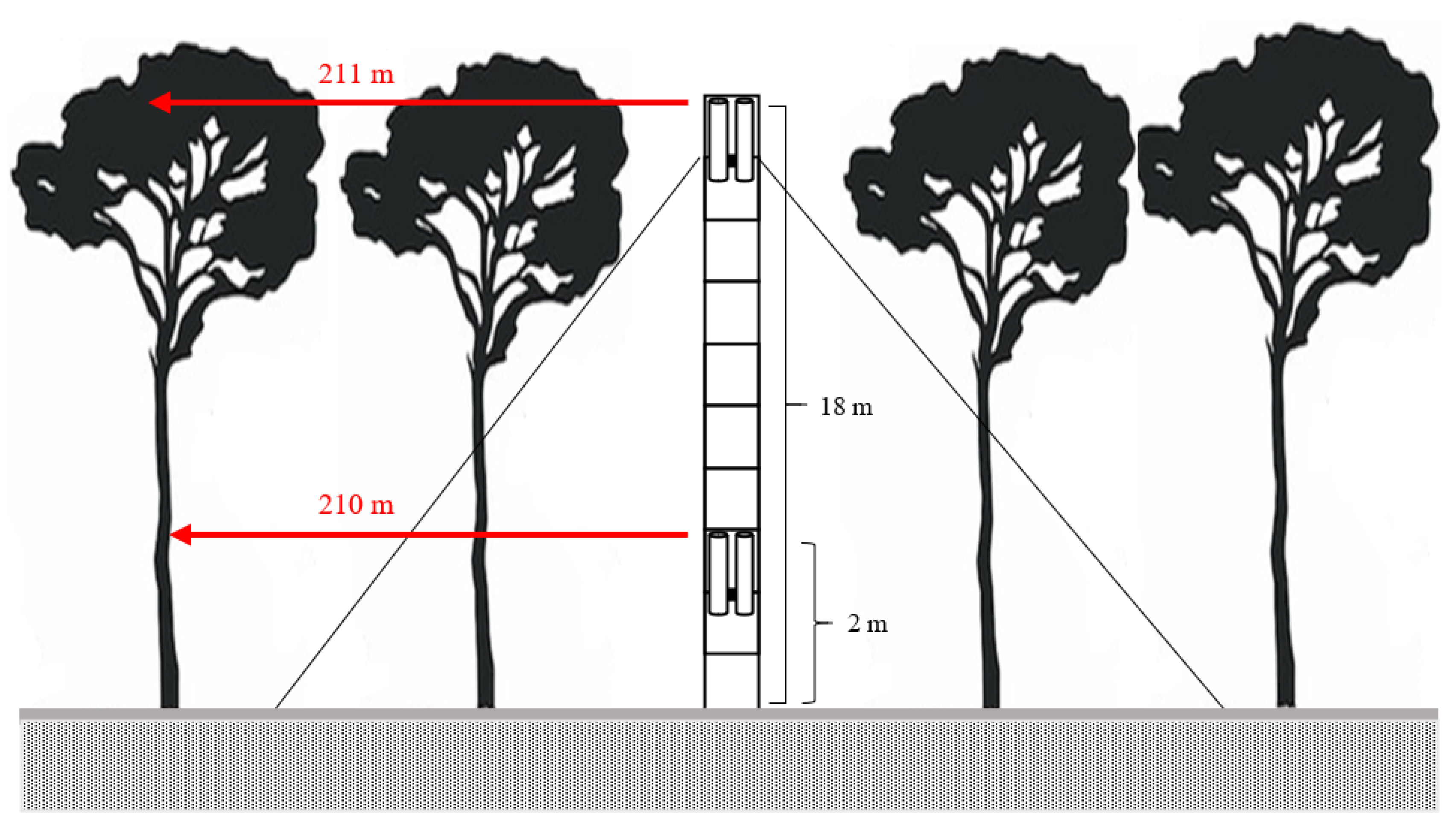
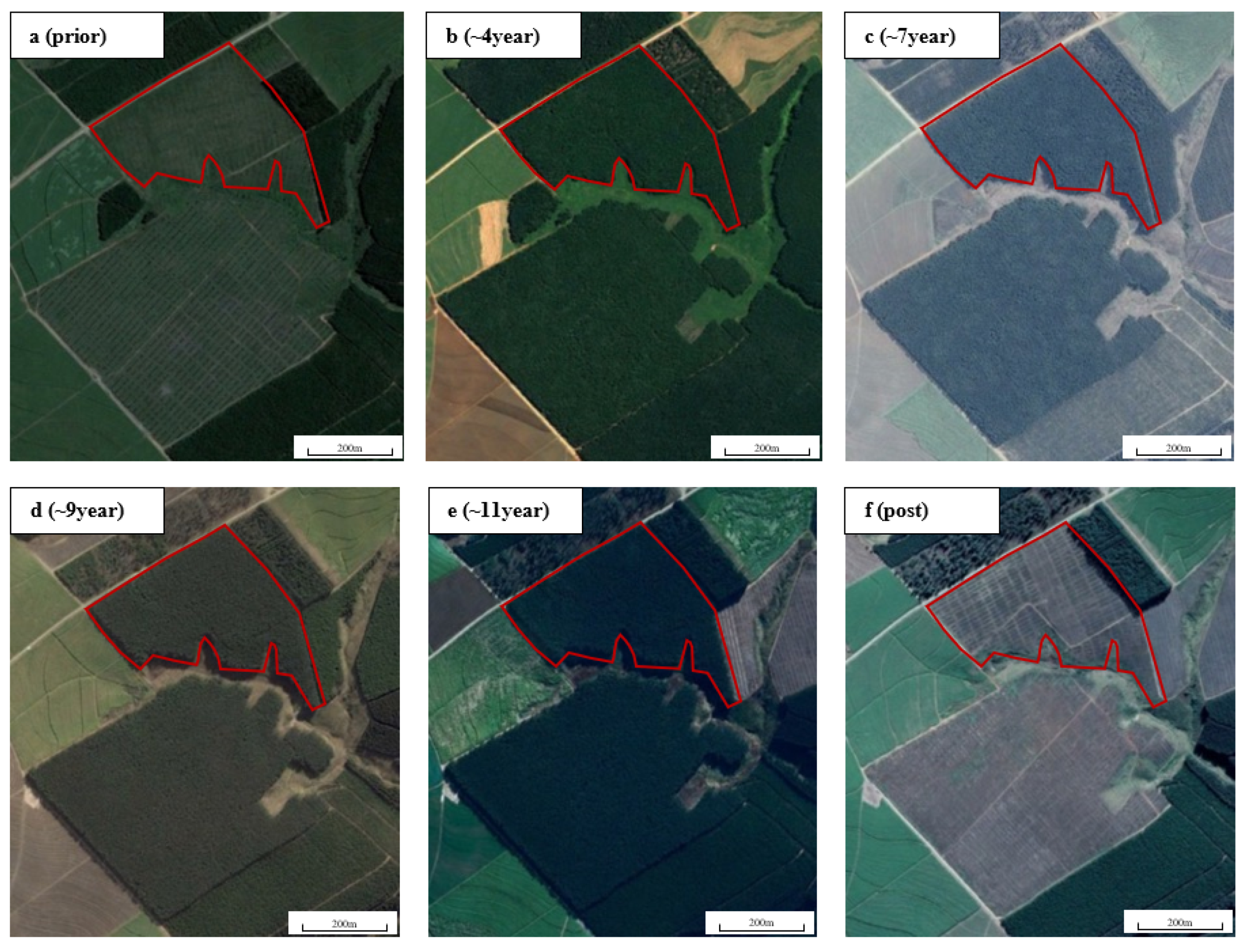

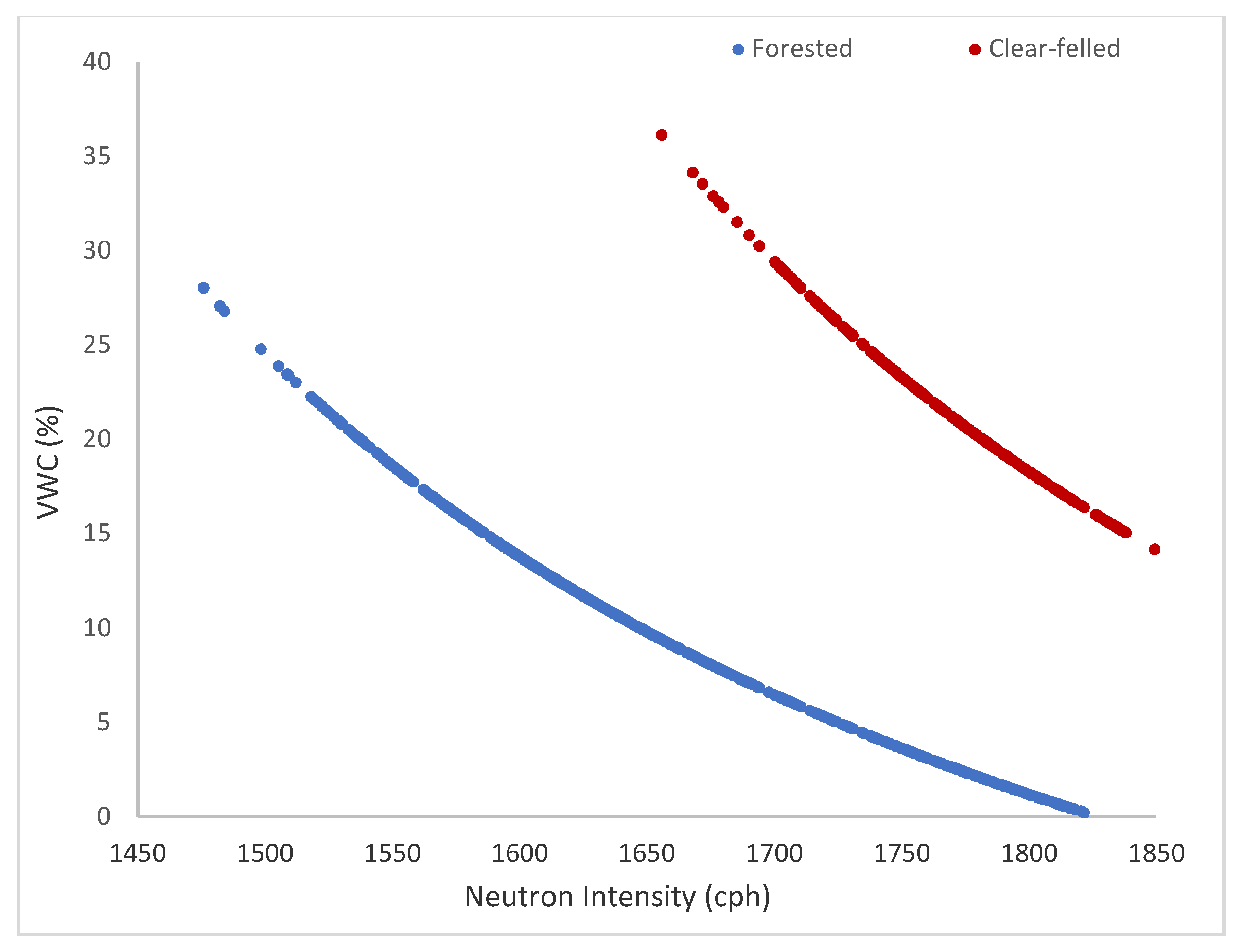

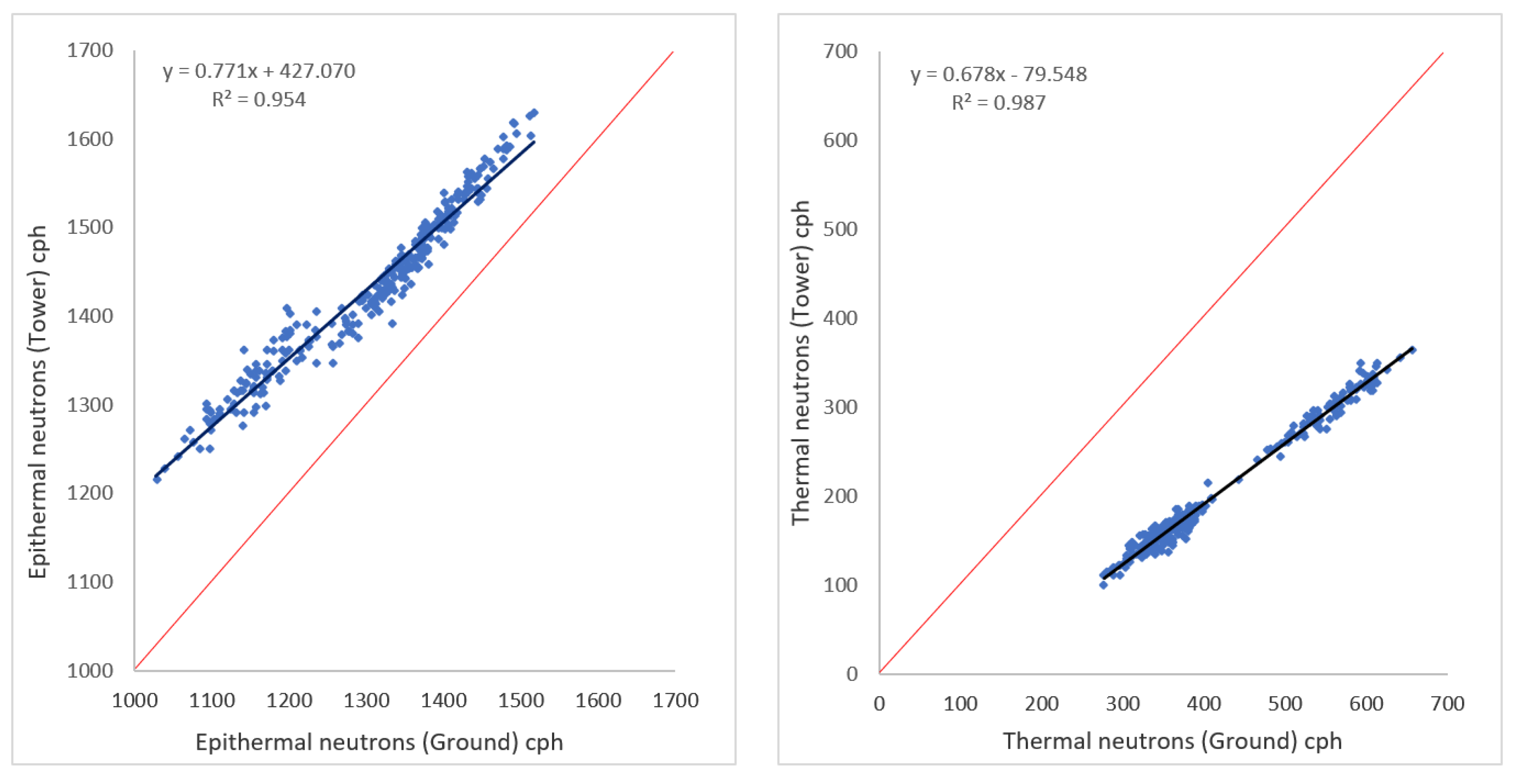
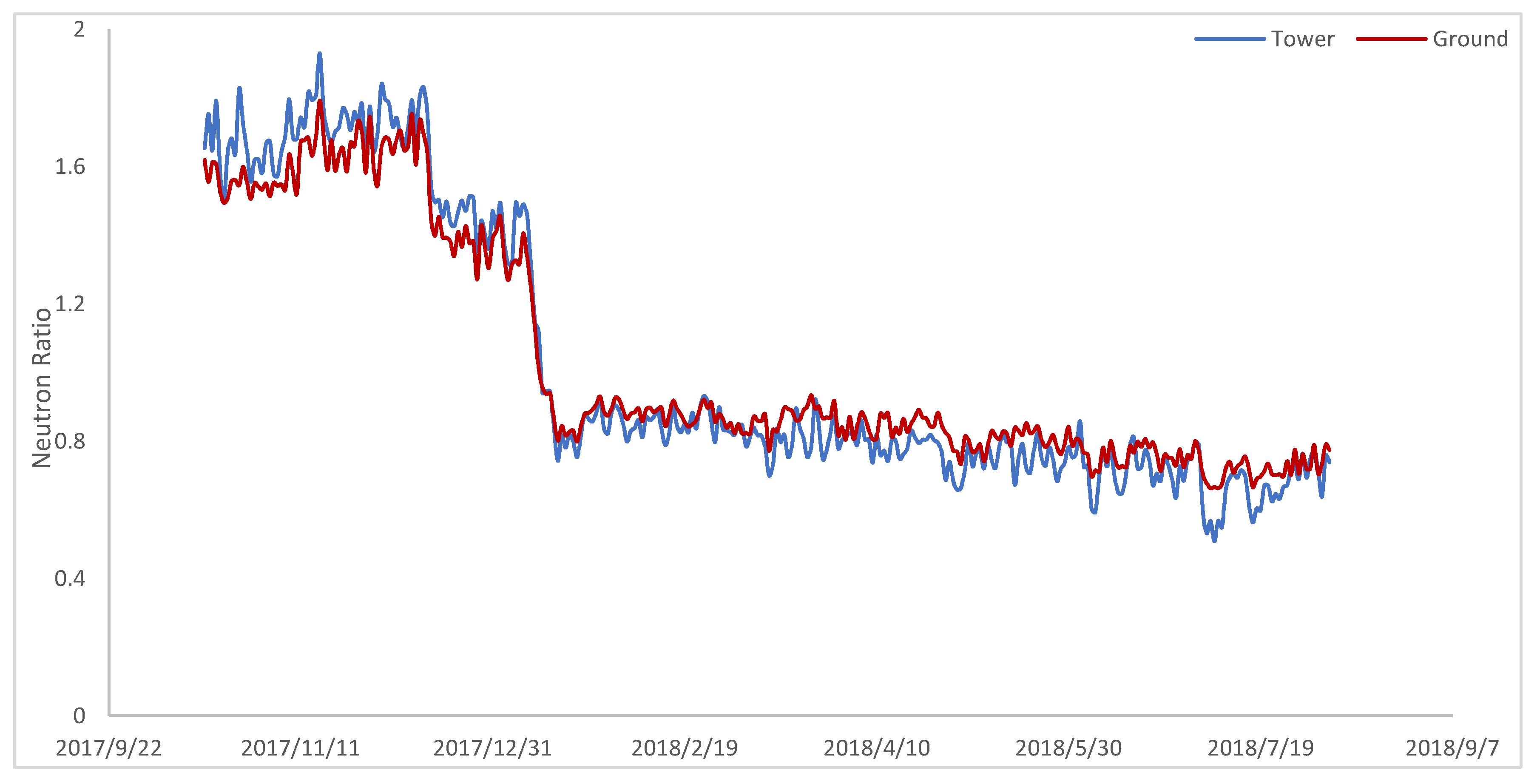
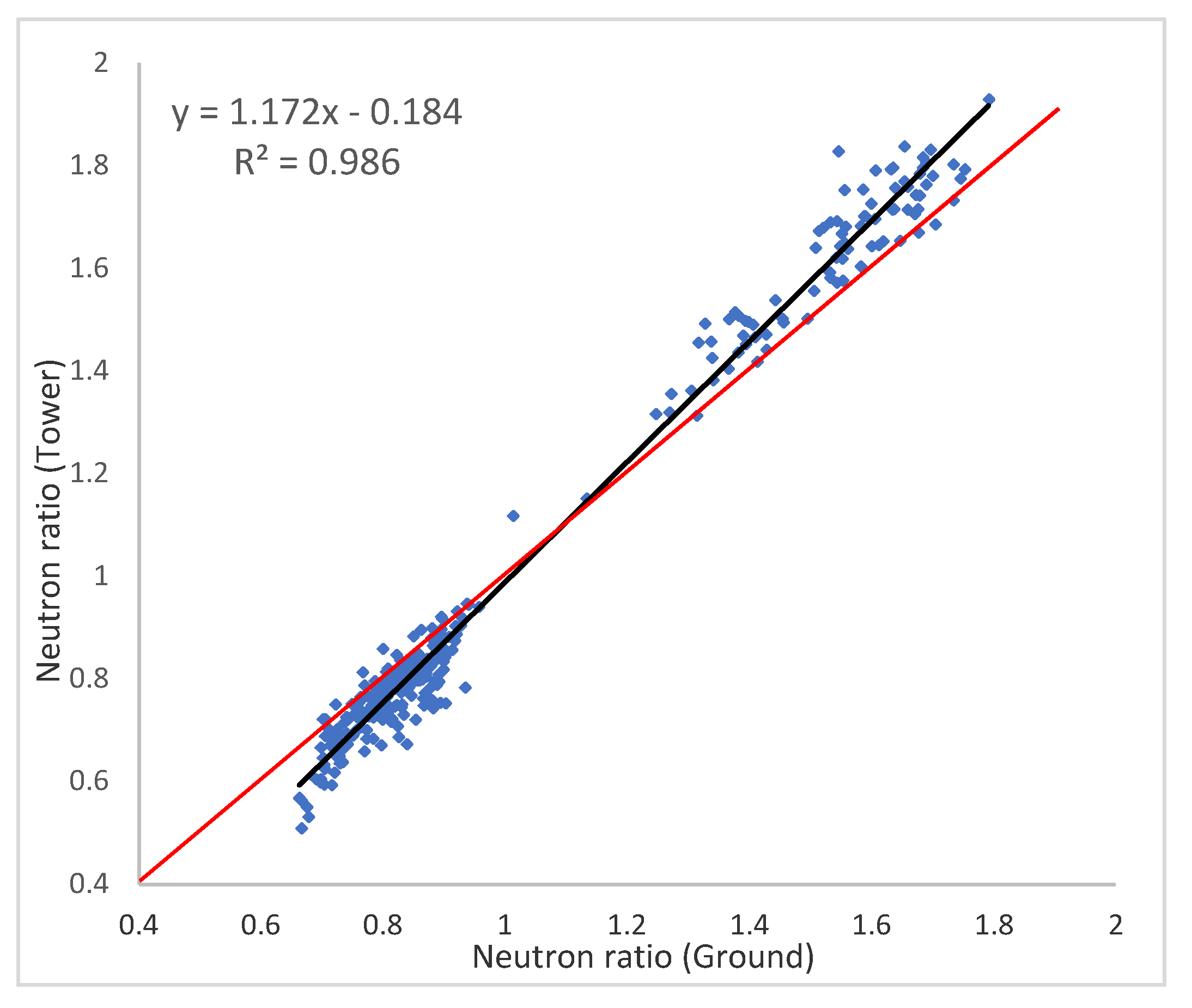
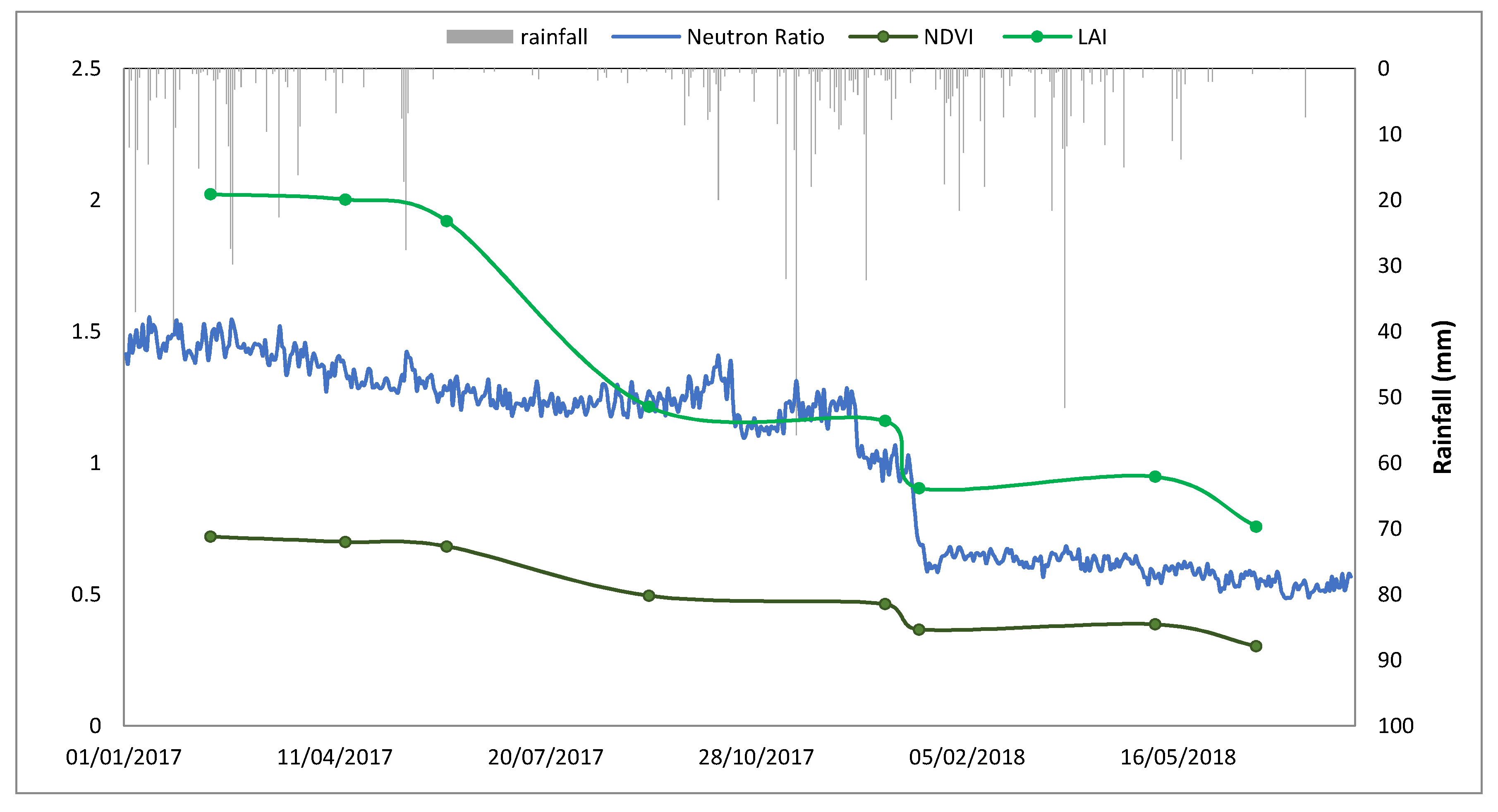
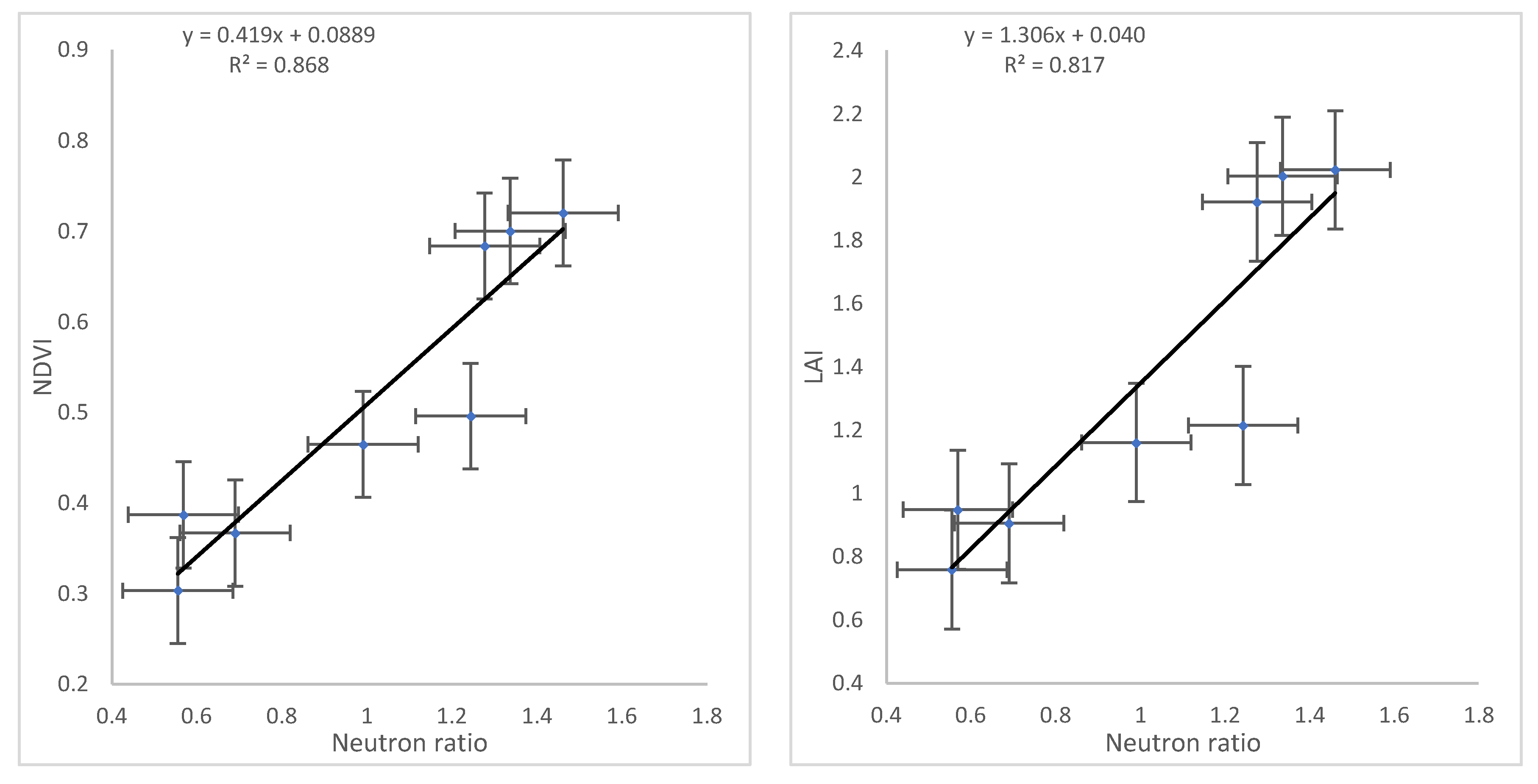
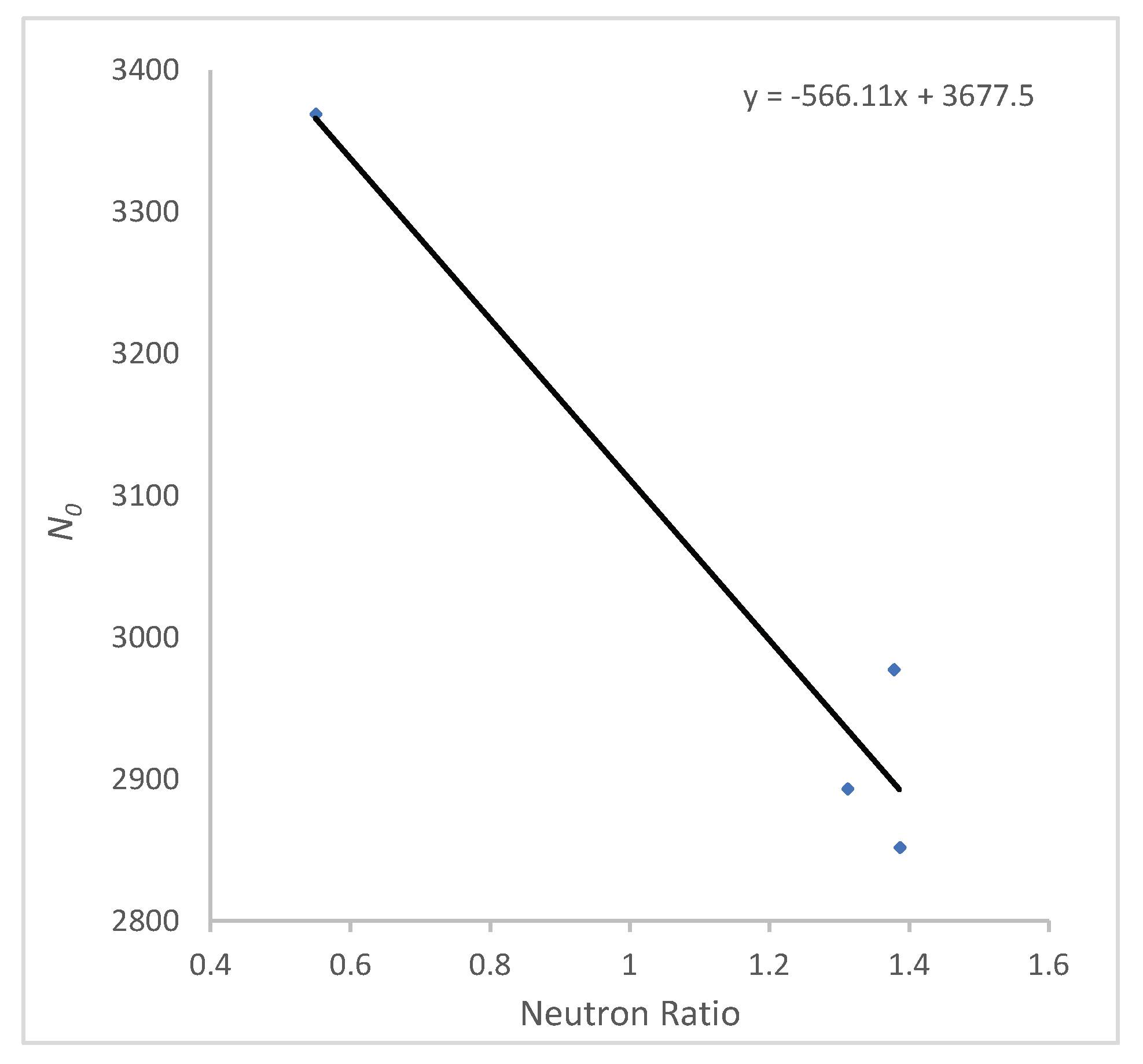
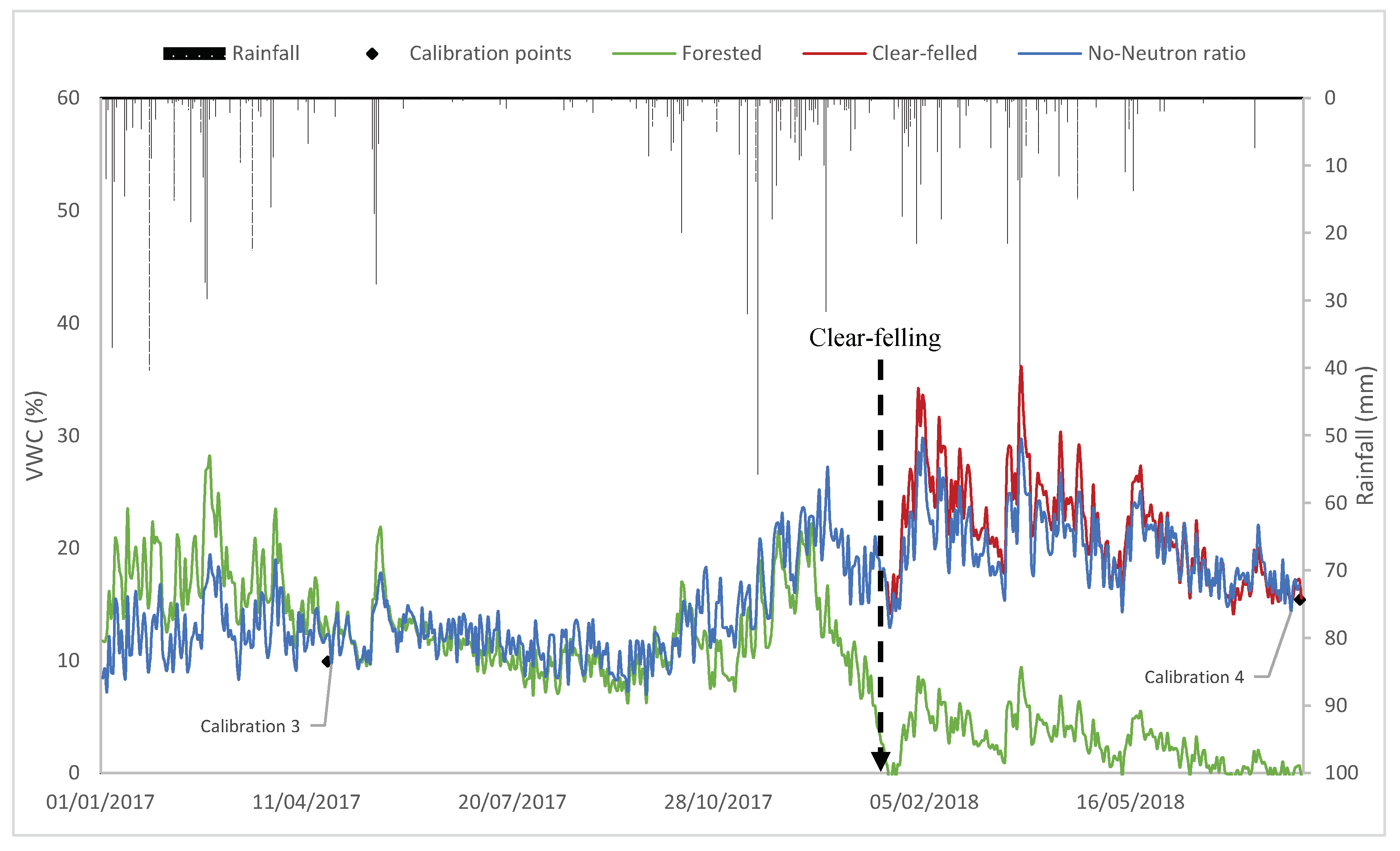
| Study | Method |
|---|---|
| Hornbuckle et al. [22] | Investigated whether the presence of growing vegetation will affect the CRNS estimates of soil water content and concluded that future research should investigate the various hydrogen pools. |
| Franz et al. [23] | Used the CRNS to estimate biomass by measuring and removing the other sources of hydrogen within the sensor’s measurement volume. |
| Bogena et al. [1] | Investigated the accuracy of the CRNS to estimate soil water content in a humid forest, which is seen as a less favourable site due to the various sources and variations in hydrogen. The study concluded that the hydrogen present in the biomass decreased the neutron intensity and the overall accuracy of the CRNS. |
| Baatz et al. [24] | Presented an empirical framework, which accounts for the epithermal neutron moderation by above-ground biomass in the calibration and found a linear correlation between N0 and dry above-ground biomass. The study found that there was a 0.9% reduction in the epithermal neutron intensity per 1 kg m−2 of dry above-ground biomass. |
| Franz et al. [25] | Found that a linear function can be used to describe the dependence of changing biomass on N0 (for maize and soybean) |
| Hawdon et al. [9] | Unveiled the relationship between N0 and biomass and noted that N0 decreases as biomass increases. |
| Baroni and Oswald [10] | Investigated a scaling approach for the assessment of biomass changes and rainfall interception using cosmic-ray neutron scaling. |
| Tian et al. [26] | Proposed the use of the neutron ratio, which is the ratio of thermal to epithermal neutron intensity, to estimate above-ground biomass. |
| Andreasen et al. [6] | Used neutron transport modelling to examine the environmental effect, which primarily focused on biomass and canopy interception, on cosmic ray neutron intensity. The study concluded that forest biomass has a significant influence on the neutron intensity. |
| Jakobi et al. [2] | Investigated the use of the CRNS to quantify soil water content and biomass, by using the neutron ratio outlined in Tian, et al. [26]. |
| Date | Condition | Neutron Count (cph) | VWC (%) | N0 |
|---|---|---|---|---|
| 04 April 2016 | Forested | 1623 | 15.60 | 2977.07 |
| 30 September 2016 | Forested | 1561 | 14.25 | 2852.00 |
| 21 April 2017 | Forested | 1658 | 9.92 | 2893.00 |
| 06 August 2018 | Clear-felled | 1824 | 15.44 | 3369.20 |
| Condition | RMSE | Bias | ubRMSE |
|---|---|---|---|
| Forested | 4.128 | −2.003 | 3.610 |
| Clear-felled | 2.320 | 1.659 | 1.622 |
| Overall | 3.599 | −0.718 | 3.526 |
© 2020 by the authors. Licensee MDPI, Basel, Switzerland. This article is an open access article distributed under the terms and conditions of the Creative Commons Attribution (CC BY) license (http://creativecommons.org/licenses/by/4.0/).
Share and Cite
Vather, T.; Everson, C.S.; Franz, T.E. The Applicability of the Cosmic Ray Neutron Sensor to Simultaneously Monitor Soil Water Content and Biomass in an Acacia mearnsii Forest. Hydrology 2020, 7, 48. https://doi.org/10.3390/hydrology7030048
Vather T, Everson CS, Franz TE. The Applicability of the Cosmic Ray Neutron Sensor to Simultaneously Monitor Soil Water Content and Biomass in an Acacia mearnsii Forest. Hydrology. 2020; 7(3):48. https://doi.org/10.3390/hydrology7030048
Chicago/Turabian StyleVather, Thigesh, Colin S. Everson, and Trenton E. Franz. 2020. "The Applicability of the Cosmic Ray Neutron Sensor to Simultaneously Monitor Soil Water Content and Biomass in an Acacia mearnsii Forest" Hydrology 7, no. 3: 48. https://doi.org/10.3390/hydrology7030048
APA StyleVather, T., Everson, C. S., & Franz, T. E. (2020). The Applicability of the Cosmic Ray Neutron Sensor to Simultaneously Monitor Soil Water Content and Biomass in an Acacia mearnsii Forest. Hydrology, 7(3), 48. https://doi.org/10.3390/hydrology7030048





